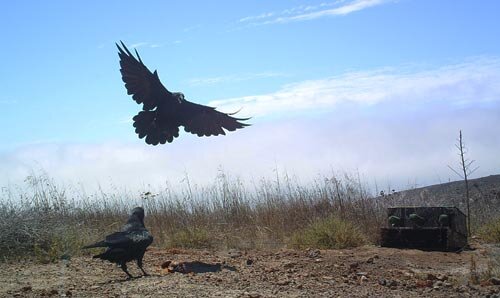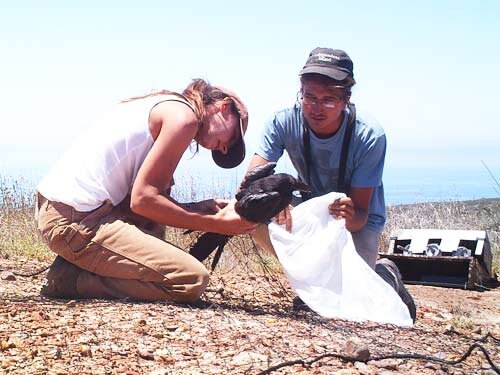Common Raven
Corvus corax
The common raven is among the widest geographically distributed birds in the world. In North America, increasing urbanization and land development have created new habitats for this readily adaptable species.
Urbanization and other forms of habitat loss have made Department of Defense (DoD) lands increasingly more important to wildlife. Common ravens are known to prey on threatened and endangered species on DoD lands, which could negatively affect the DoD’s efforts to promote recovery and long-term population viability of these rare species.
The San Clemente loggerhead shrike (Lanius ludovicianus mearnsi;SCLS) was officially listed as endangered under the U.S. Endangered Species Act in 1977 and only 14 individuals remained in the wild in 1998, making it among the most endangered avian populations in the world. The U.S. Navy and other collaborators have conducted an intensive recovery effort and the population has rebounded to >60 wild breeding pairs. However, predation continues to pose a threat to population recovery and the eventual goal of recovery and delisting. Observations over the course of the recovery project, particularly in 2010, indicate common ravens may be significant predators of shrike nests. It is likely that predation risk is highest when ravens are feeding offspring. As large-scale lethal control of native ravens does not fulfill the Navy’s goal of maintaining naturally occurring wildlife populations on its bases, evaluation of the impacts ravens are having on shrikes and subsequently developing methods to minimize and mitigate these impacts are necessary.
Baited by cheesy puffs
In 2011, the Institute for Wildlife Studies (IWS) began studying common ravens in an effort to better understand how they may affect the SCLS and what management actions might be effective in deterring predation of listed species. We first identified areas where raven predation of SCLS has recently occurred and focused trapping efforts within these areas. We are currently marking ravens with patagial tags and Federal (U.S.G.S. Banding Lab) leg bands to facilitate identification. We also attached radio-transmitters to 12 ravens and radio-tracked them to determine home range and habitat usage. Additionally, we use information from remote video camera systems deployed at shrike nests to identify any predations by marked individuals.
Our study provides baseline data to help us work with the Navy to develop non-lethal raven management methods. Our results include management recommendations to better mitigate for threats ravens pose to threatened and endangered species on San Clemente Island and at other DoD installations IWS biologists are experimentally testing management recommendations.


Ravens baited into position for rocket net deployment

IWS biologists remove a raven from the net

Captured bird fitted with a transmitter and patagial tags

IWS biologist Anička Kratina-Hathaway ready to release raven #25 from her "ice cream cone" grip



